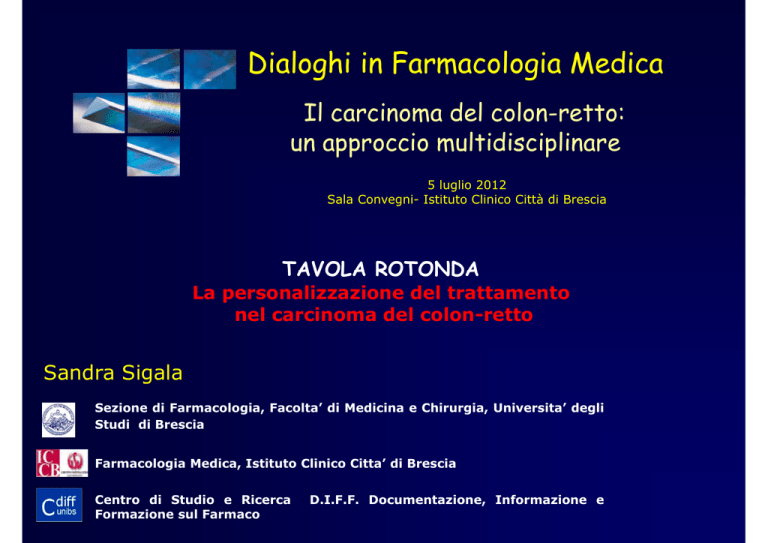
Dialoghi in Farmacologia Medica
Il carcinoma del colon-retto:
un approccio multidisciplinare
5 luglio 2012
Sala Convegni- Istituto Clinico Città di Brescia
TAVOLA ROTONDA
La personalizzazione del trattamento
nel carcinoma del colon-retto
Sandra Sigala
Sezione di Farmacologia, Facolta’ di Medicina e Chirurgia, Universita’ degli
Studi di Brescia
Farmacologia Medica, Istituto Clinico Citta’ di Brescia
Centro di Studio e Ricerca
Formazione sul Farmaco
D.I.F.F. Documentazione, Informazione e
NEO- ADIUVANTE
solo K retto
ADIUVANTE
I LINEA METASTATICA
I LINEA METASTATICA
5-fluorouracile
acido folinico
FOLFOX
5-fluorouracile
acido folinico
oxaliplatino
FOLFOXIRI
5-fluorouracile
acido folinico
irinotecan
oxaliplatino
FOLFIRI
5-fluorouracile
acido folinico
irinotecan
ANTIMETABOLITI: ANALOGHI DELLE PIRIMIDINE
Il meccanismo d'azione di 5-FU richiede la
conversione
enzimatica
a
fluorouridilmonofosfato
(FUMP) e segue le vie
metaboliche dell’uracile
Il FUMP, ad opera della timidina-fosforilasi e timidinachinasi,
viene
convertito
in
5fluorodesossiuridilmonofosfato (FdUMP) che blocca
l'enzima timidilato-sintetasi, arrestando la sintesi di
timidina e del DNA
Il fluorouridilmonofosfato (FUMP) viene fosforilato a
fluorouridiltrifosfato (FUTP) che viene incorporato
nell'RNA nucleare e citoplasmatico alterandone le
funzioni
Il FUMP viene convertito in desossiribonucleotide
(FdUMP), fosforilato (FdUTP) e incorporato nel DNA
compromettendone la stabilità.
AGENTI ALCHILANTI
L’oxaliplatino è un complesso del Pt che presenta il
nucleo 1,2-diamminocicloesano (DACH). E’ presente anche
un gruppo ossalato.
L’intermedio metabolico, in cui il DACH-Pt è legato a due
molecole d’acqua, va a reagire con i gruppi sulfidrilici e
amminici delle proteine, del RNA e del DNA. L’efficacia
antitumorale del farmaco si pensa sia dovuta soprattutto
alla formazione di addotti DACH-Pt-DNA.
Il gruppo DACH dell’oxaliplatino permette il suo utilizzo
anche nei tumori cisplatino e carboplatino/dipendenti: è più
voluminoso e più idrofobico e la formazione poi dell’addotto
rappresenta, quindi, un notevole ingombro sterico che
deforma il DNA. Le lesioni formate dall’oxaliplatino
risultano, quindi, più citotossiche rispetto a quelle formate
da cisplatino o carboplatino.
Il potere citotossico degli addotti formati deriva dalla loro
capacità di deformare in maniera significativa la struttura
tridimensionale del DNA. I meccanismi cellulari di riparo, a
causa della forte deformazione del DNA, non legano i
complessi formati dall’oxaliplatino, mentre riconosce quelli
formati dal cisplatino.
Clin Cancer Res 14: 1610, 2008
DERIVATI DELLA CAMPTOTHECA ACUMINATA: INIBITORI ENZIMATICI
Irinotecan è un inibitore della topoisomerasi I.
L’a topoisomerasi I «srotola» il DNA, provocando single strand breaks che
riducono la torsione del DNA supercoiled. Fisiologicamente, questo effetto è transitorio e i
single strand breaks sono rapidamente riparati dalla topoisomerasi I stessa.
Il legame con SN-38 inibisce il meccanismo di riparo e stabilizza il complesso
single strand breaks-topoisomerasi I, portando alla rottura definitiva del DNA e a morte
cellulare.
Giamas et al, Cellular Signalling 22, 984-1002, 2010
Approvato nel 2004 dalla FDA
cetuximab
Easley and Kirkpatrick
Lièvre A et al. Cancer Res 2006;66:3992-3995
Example of different genetic alterations studied.
A and B, electrophoregram from normal (A) and tumor tissue (B). A G12D KRAS
mutation is observed in tumor tissue compared with normal tissue.
C, an example of high EGFR amplification by chromogenic in situ hybridization..
One brown spot corresponds to one EGFR gene copy.
V600E
vemurafenib
BEVACIZUMAB: approvato nel 2004 dalla FDA
“ However, only recently have we been able to demonstrate
that antiangiogenic therapy (anti–vascular endothelial growth
factor [VEGF] therapy in combination with chemotherapy)
could improve overall survival and provide excellent disease
control in patients with metastatic CRC.
With the recent US Food and Drug Administration approval of
bevacizumab in combination with intravenous 5-fluorouracil
(5-FU), oncologists now have numerous options in regards to
treating patients with metastatic disease.”
Jubb et al. Nature Reviews Cancer , doi:10.1038/nrc1946
Jubb et al. Nature Reviews Cancer , doi:10.1038/nrc1946
Chronic exposure of CRC cells to
Bev leads to increased migration
and invasion in vitro that is
associated
with
increased
expression of alternate VEGF
family ligands and activation of
VEGFR-1.
Inhibition of activation of VEGFRs
blocked the increase in migration
observed in Bev-adapted cells.
Bevacizumab-adapted
cells
exhibited an increase in metastatic
potential in vivo.
Beyond bevacizumab: new anti-VEGF strategies in colorectal cancer.
Expert Opin Investig Drugs 2012 Jul;21:949-59.
Presently, eight novel antiangiogenic agents are in Phase III trials and a wide range of other
candidates are being tested in Phase I/II trials. Given the preliminary positive results of two recent
Phase III trials, aflibercept and regorafenib, probably, will be new-targeted agents
approved for the treatment of mCRC.
Aflibercept
(VEGF trap): A protein
comprised
of
segments
of
the
extracellular domains of human vascular
endothelial growth factor receptors 1
(VEGFR1) and 2 (VEGFR2) fused to the
constant region (Fc) of human IgG1 with
potential
antiangiogenic
activity.
Disruption of the binding of VEGFs to
their cell receptors may result in the
inhibition
of
tumor
angiogenesis,
metastasis,
and
ultimately
tumor
regression.
Nature Medicine 17: 1371, 2011
Regorafenib: An orally bioavailable small molecule that inhibits vascular VEGFR 2 and 3,
and Ret, Kit, PDGFR and Raf kinases, which may result in the inhibition of tumor
angiogenesis and tumor cell proliferation.
VEGFRs are receptor tyrosine kinases that play important roles in tumor angiogenesis; the receptor
tyrosine kinases RET, KIT, and PDGFR, and the serine/threonine-specific Raf kinase are involved in tumor
cell signaling.
Colorectal tumours that are KRASwt are often sensitive to EGFR blockade, but almost
always develop resistance within several months of initiating therapy.
The mechanisms underlying this acquired resistance to anti-EGFR antibodies are largely
unknown.
The simplest hypothesis to account for the development of resistance to EGFR
blockade is that rare cells with KRAS-mutations preexist at low levels in tumours with
ostensibly wild-type KRAS genes.
Resistance is therefore a fait
accompli and the time to recurrence
is simply the interval required for the
subclone to repopulate the lesion.
21 ± 8.5w
To make these remissions last
longer
than 5 to
6
months,
combination therapies targeting at
least two different pathways will be
required
25 ± 10w

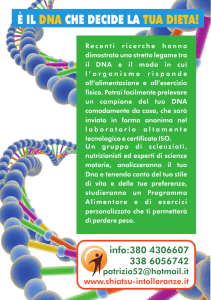
![mutazioni genetiche [al DNA] effetti evolutivi [fetali] effetti tardivi](http://s1.studylibit.com/store/data/004205334_1-d8ada56ee9f5184276979f04a9a248a9-300x300.png)
![ESTRAZIONE DNA DI BANANA [modalità compatibilità]](http://s1.studylibit.com/store/data/004790261_1-44f24ac2746d75210371d06017fe0828-300x300.png)
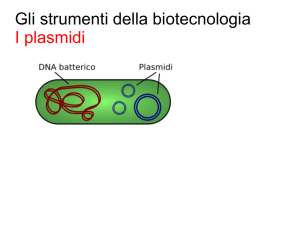
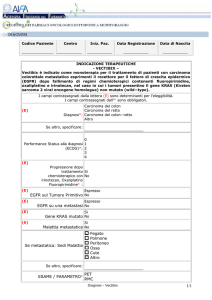
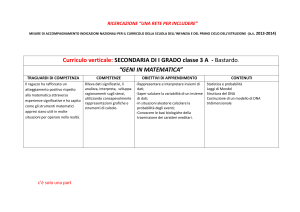
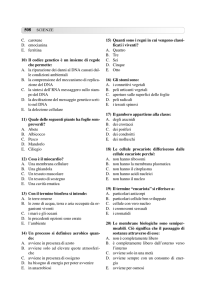

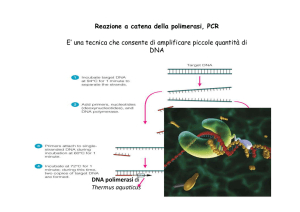
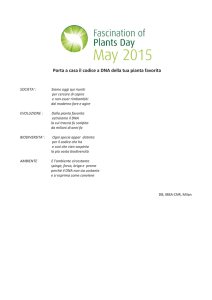
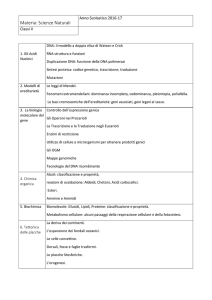
![(Microsoft PowerPoint - PCR.ppt [modalit\340 compatibilit\340])](http://s1.studylibit.com/store/data/001402582_1-53c8daabdc15032b8943ee23f0a14a13-300x300.png)